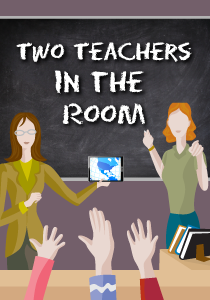Pushing Beyond Our Co-Teaching Comfort Zones
A MiddleWeb Blog

We transition to our most comfortable classroom persona—and then it becomes like we never left! But here’s the thing…co-teachers must push beyond this familiar way of being. They must push beyond co-teaching comfort zones.
This year, I’m enjoying a new position as an instructional coach. I will be working with special education teachers and general education teachers in special classes and inclusion classes to align IEP goals and Common Core curriculum.
Our objective will be to guide each student to close personal achievement gaps, which will naturally lead to closing building and district-wide achievement gaps.
I will be working with teachers and co-teachers across the district—it’s like co-teaching times ten! My passion to elevate co-teaching in inclusion classrooms feels boundless and I am full of hope for student achievement. I will be a guide on the side in learning environments with such a variety of co-teaching realities, and I am very jazzed about the opportunity to fine tune strategies and models of instruction that will work for each classroom scenario.
The characteristics of good partnerships
As I reflect on my past co-teaching experiences, and look forward to co-teaching with my many new colleagues this year, I’ve been taking some time to consider which characteristics should be a part of any effective co-teaching partnership.
1. Positive Classroom Environment: Each classroom should include a natural proportion of students with disabilities, with all students in flexible, heterogeneous groups. Mutual respect is obvious between teachers, between teachers and students, and between students and students. The thinking of all students is valued, and time is naturally embedded in lessons where students are actively engaged and comfortable sharing their voices.

3. Effective Instructional Practices: Differentiated strategies and the use of a variety of co-teaching models are evident. The needs of a variety of students are clearly being met through the use of materials and technology as needed. A balance of cooperative learning groups (with flexible groupings considered) and independent practice is in place. Structured peer supports are in use to increase student leadership opportunities, deepen learning, and strengthen social and behavioral skills. Specific learning strategies are in place to scaffold instruction and support challenging work. Both teachers are involved in checking for students’ understanding and adjusting scaffolds as needed.
4. Accommodations and Modifications: Both teachers demonstrate an awareness of individual student needs. Proactive planning is evidenced by the smooth flow of a lesson where all students are able to access the material in real-time. Students’ needs for any technologies are accessible to guide meaningful student participation. Accommodations for assessments are naturally embedded. Incorporating a Universal Design for Learning approach will limit, and potentially do away with, any need for retrofitting.
The Co’s of Co-Teaching

In addition to these fundamental characteristics of effective inclusion classrooms, I’ll be looking for these indicators of good co-teaching that are often “outside the comfort zone.”
► There is evidence that the teachers co-plan. Instructional methods are selected based on content as well as students’ strengths and needs. Lesson plans are written in a manner that delineates each teacher’s role in the planning and instructional process.
► There is evidence that the teachers co-instruct. It is obvious that the teachers utilize various co-teaching models. It would be difficult for an outsider to identify the general education teacher and the special education teacher. Teachers interact in ways to deepen the learning for all learners in the room.
► There is evidence that the teachers co-assess. Both teachers take part in accommodating and/or modifying assignments to guide meaningful student expression where all students are held to the same high standards and expectations. Both teachers have a role in collecting data on student performance, and both teachers take a part in creating and/or grading assessments.
What are your thoughts about these characteristics and indicators of a strong co-teaching relationship? Are they realistic in your co-teaching world? What plans do you have for pushing beyond your own co-teaching comfort zones this year?




































Very interesting perspectives on coteaching (inclusionary model). Natural proportion is critical to success-generally the % of sped pop in coteach model reflects % of exceptional learners in bldg., at lease in perfect world scenario. I haven’t seen this % in many, many years (I’ve been teaching exceptional learners for 40+ yrs. & coteaching for over 18 yrs.). What I see is a loading of sped. , RTI & ELL students so proportion is way out of whack- sometimes these challenging pops are over 50% in a coteach class!
Coteach relationship varies from teacher to teacher. When I coteach with different teachers I have different relationships with each, depending on lots and lots of variables.
Least Restrictive Environment (LRE) is the PL94-142 term, but inclusion has become the political one!! LRE does not mean that all exceptional learners benefit from a coteach model, must make placement decision on an individual basis-what’s best for one kid may not be best for all.